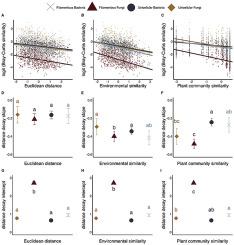Fungal Ecology ( IF 1.9 ) Pub Date : 2020-05-20 , DOI: 10.1016/j.funeco.2020.100948 S. Caroline Daws , Lauren A. Cline , John Rotenberry , Michael J. Sadowsky , Christopher Staley , Brent Dalzell , Peter G. Kennedy

|
Although it has been commonly observed that fungi and bacteria differ in their regional biogeographic patterns, it is not well understood what traits contribute to these different distributions. Here, we evaluate how morphological type (i.e. unicellular or filamentous growth form) influences the biogeography of soil fungal and bacterial communities across not only Euclidean (i.e. geographic) distances, but also across gradients of climate and edaphic factors and plant community composition. Specifically, we assessed the decay in community similarity over distance (distance-decay relationship) for microbes with unicellular and filamentous morphology in both fungi and bacteria across 40 ecologically diverse sampling sites in Minnesota, USA. Overall, we found that while distance-decay relationships were similar in fungal and bacterial communities over Euclidean distances, there were important differences among morphological groups of fungi and bacteria across gradients of environmental and plant community similarity. Specifically, the distance-decay relationship of unicellular fungi and unicellular bacteria were indistinguishable across environmental similarity. However, as plant community similarity decreased, only filamentous fungi and unicellular bacteria differed significantly in the strength of their distance-decay relationships. Like analyses of other study systems, we also found that pH explained much of the variance in community composition across microbial domains and morphological types and that plant community diversity was more closely correlated with fungal diversity than with bacterial diversity. Collectively, our results suggest that specific ecological traits such as morphological type along with microbial domain are key factors shaping the biogeography of microbial communities.
中文翻译:

共有的特征会带来相同的命运吗?检查真菌和细菌群落的形态类型与生物地理学之间的联系
尽管通常观察到真菌和细菌在其区域生物地理模式上有所不同,但人们尚未完全了解哪些特征促成这些不同的分布。在这里,我们评估形态类型(即单细胞或丝状生长形式)如何不仅影响欧几里得距离(即地理距离),而且影响气候和人类因素以及植物群落组成的梯度,从而影响土壤真菌和细菌群落的生物地理学。具体而言,我们评估了美国明尼苏达州40个生态多样的采样点中真菌和细菌中具有单细胞和丝状形态的微生物在距离上的群落相似度随距离的衰减(距离-衰减关系)。总体,我们发现,尽管在欧氏距离上真菌和细菌群落的距离衰减关系相似,但在环境和植物群落相似度梯度上,真菌和细菌的形态学组之间存在重要差异。具体而言,单细胞真菌和单细胞细菌的距离-衰减关系在环境相似性之间是无法区分的。但是,随着植物群落相似性的降低,只有丝状真菌和单细胞细菌在距离衰减关系上的强度差异显着。像其他学习系统的分析一样,我们还发现,pH值解释了微生物区域和形态类型之间群落组成的大部分差异,并且植物群落多样性与真菌多样性比与细菌多样性更紧密相关。总体而言,我们的研究结果表明,特定的生态特征(例如形态类型以及微生物域)是塑造微生物群落生物地理学的关键因素。











































 京公网安备 11010802027423号
京公网安备 11010802027423号